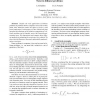Free Online Productivity Tools
i2Speak
i2Symbol
i2OCR
iTex2Img
iWeb2Print
iWeb2Shot
i2Type
iPdf2Split
iPdf2Merge
i2Bopomofo
i2Arabic
i2Style
i2Image
i2PDF
iLatex2Rtf
Sci2ools
ICCV
2001
IEEE
2001
IEEE
Noise in Bilinear Problems
: Despite the wide application of bilinear problems to problems both in computer vision and in other fields, their behaviour under the effects of noise is still poorly understood. In this paper, we show analytically that marginal distributions on the solution components of a bilinear problem can be bimodal, even with Gaussian measurement error. We demonstrate and compare three different methods of estimating the covariance of a solution. We show that the Hessian at the mode substantially underestimates covariance. Many problems in computer vision can be posed as bilinear problems: i.e. one must find a solution to a set of equations of the form ck = ij gijkaibj for ck a set of known terms (henceforth measurements), and gijk a set of known interaction terms. Typically, ai and bj are constrained in some way to allow a unique solution. The most familiar example is Tomasi and Kanade's formulation of orthographic structure-from-motion [9]; shapefrom-shading and other vision problems can...
Bilinear Problems | Bimodal Marginal Posteriors | Computer Vision | Gaussian Measurement Error | Gaussian Noise | ICCV 2001 | Straightforward Covariance Estimates |
| Added | 15 Oct 2009 |
| Updated | 15 Oct 2009 |
| Type | Conference |
| Year | 2001 |
| Where | ICCV |
| Authors | John A. Haddon, David A. Forsyth |
Comments (0)

